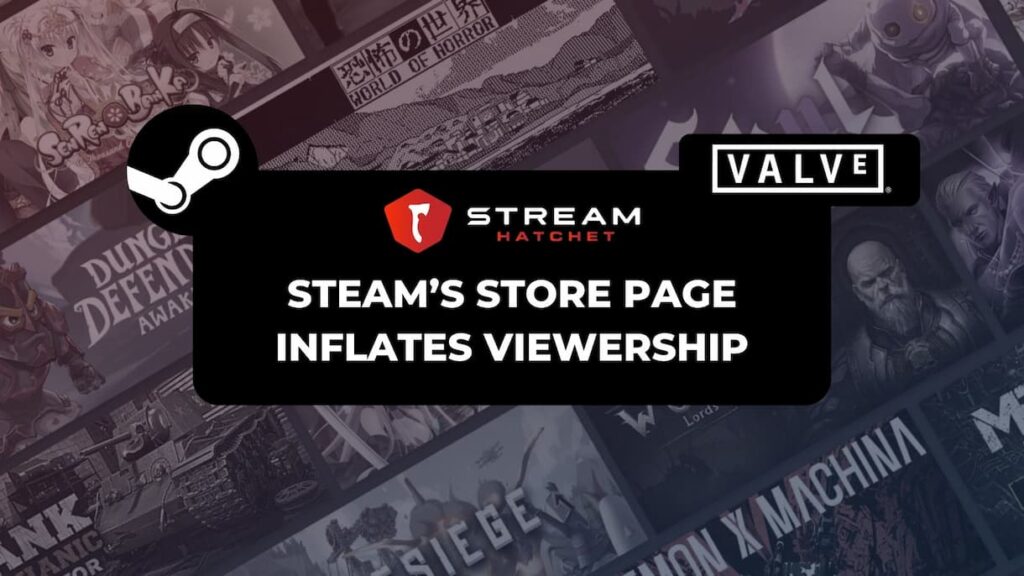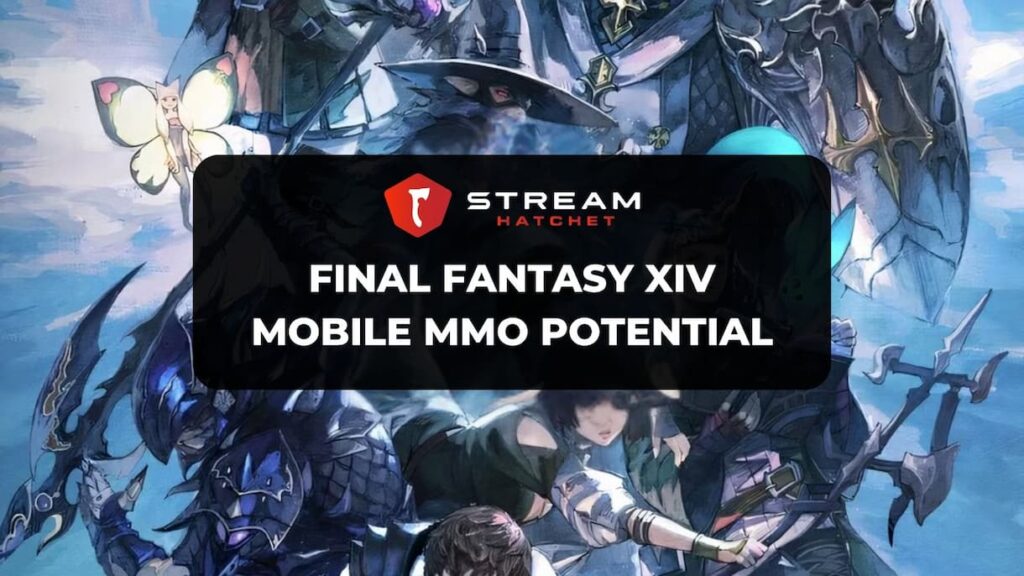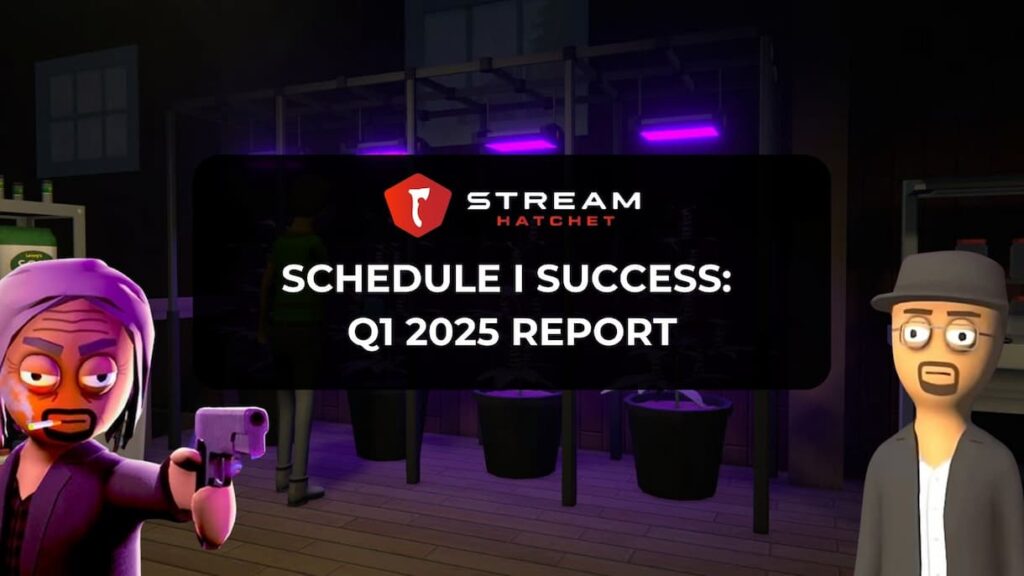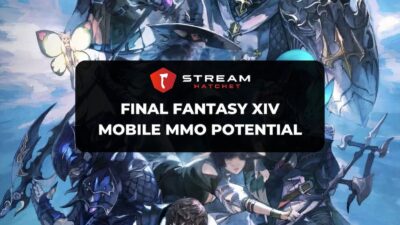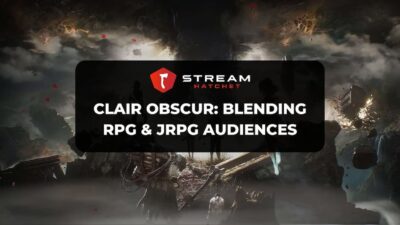Hunt: Showdown recently made a massive update to the base game: Hunt: Showdown 1896. This update feels like a brand-new game with a slew of content and tweaks to existing mechanics. However, developer Crytek needed a way to get the news out to the broader Hunt: Showdown community and fans of other extraction shooters like Escape from Tarkov.
One of the best ways to hype up a game’s fanbase is a Twitch Drops campaign. For the uninitiated, Twitch Drops campaigns are special events hosted on Twitch in which viewers who watch participating streamers can receive in-game loot for the featured game. In the past, we’ve looked at the mechanics of Twitch Drops campaigns and how they can be used to boost game viewership and celebrate moments with the community.
In this article, we’ll be seeing these principles in action with Hunt: Showdown 1896, including the lasting effect of its Twitch Drops campaign and the extra community efforts that Crytek employed to reinforce the game’s launch.
Twitch Drops Increased Hunt: Showdown’s Viewership… But Did the Effect Last?
The Twitch Drops campaign for Hunt: Showdown 1896 ran from the 16th to the 23rd of August and, as expected, led to a dramatic improvement in viewership for the game. Comparing the week before to the week of the Twitch Drops campaign, viewership rose from 1.3M hours watched to 7.2M hours watched – a jump of 471%. Average viewership rose by a similar amount, while peak viewership doubled from 47.4K to 97K. On the 22nd of August, the developers even announced a record 100K concurrent players.
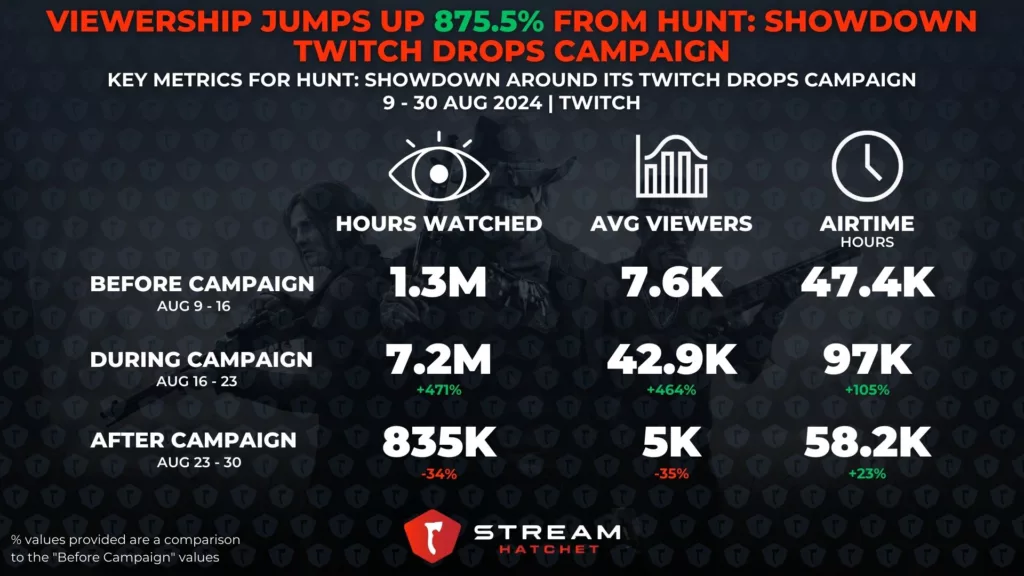
Of course, this boost wasn’t just due to the Twitch Drops campaign. Apart from the game’s new content, Crytek held a number of simultaneous deals and events to provide support for the new title. The biggest impact on Hunt: Showdown viewership was a free debut weekend on both Steam and Xbox (for Game Pass holders) where new players could try out the game for absolutely nothing. Other initiatives included a community live stream (also participating in the Twitch Drops campaign), a concert at Gamescom, and a commemorative wallpaper giveaway. Finally, Crytek planned long-term by shouting out the Hunt: Showdown community Discord and a community survey – both designed to make fans feel involved in the game’s ongoing development.
When comparing the before and after viewership for the Hunt: Showdown’s Twitch Drops campaign, things get a little more complicated. At first glance, it appears as though hours watched dropped by 34% in the week after Twitch Drops from the week before Twitch Drops. It would seem that the campaign isn’t effective… but a different perspective reveals the truth.
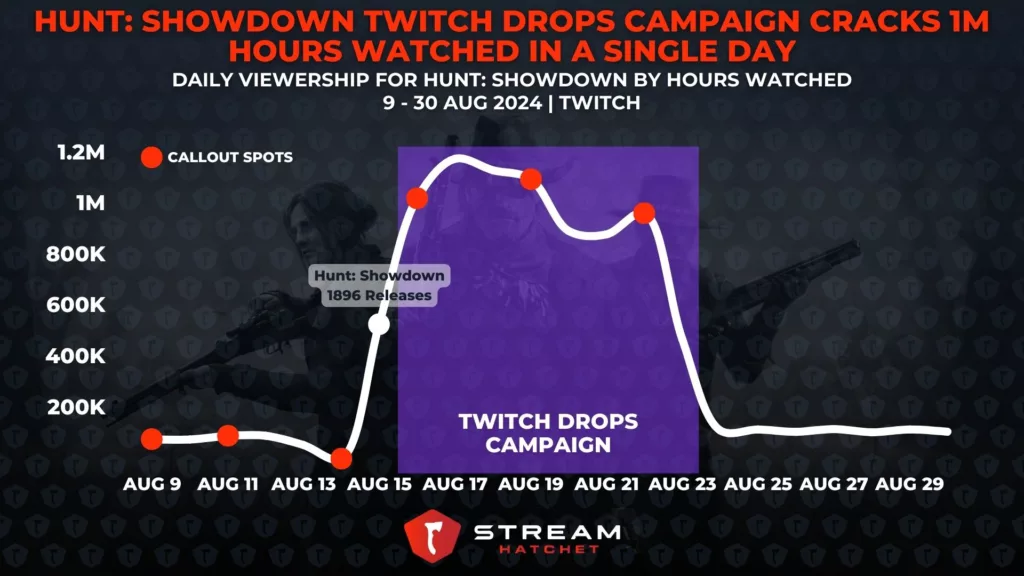
In actuality, the “before” figures have been inflated by an early rise in viewership on the 15th of August. The 1896 update for Hunt: Showdown actually launched one day earlier than the beginning of the Twitch Drops campaign, bringing in a daily viewership of 532K hours watched. Comparing the viewership from before this date to those days after the Twitch Drops campaign reveals a more accurate observation: A rise in hours watched of roughly 10%.
There is strong evidence that the dramatic increase in Hunt: Showdown viewership is due primarily to the Twitch Drops campaign rather than just the new 1896 content alone. Firstly, after the 23rd of August (the last day of Twitch Drops), viewership steeply drops back down to 114K hours watched. Secondly, the official Hunt: Showdown X page tweeted “callouts” to remind players about the Twitch Drops event at regular intervals. For those days featuring callouts during the Twitch Drops campaign (16th, 19th, 22nd), viewership for the game bumped back up.
It seems clear, then, that the Twitch Drops campaign helped not only provide a temporary boost to Hunt: Showdown, but created a lasting increase even in the following week as well.
Twitch Drops Campaigns Are a Big Boon to Streamers As Well
Twitch Drops campaigns are not just great for the developer, however. The collaboration can also attract new eyes to participating streamers, and if they can put on a good show, those viewers may stick around long after the campaign is over.
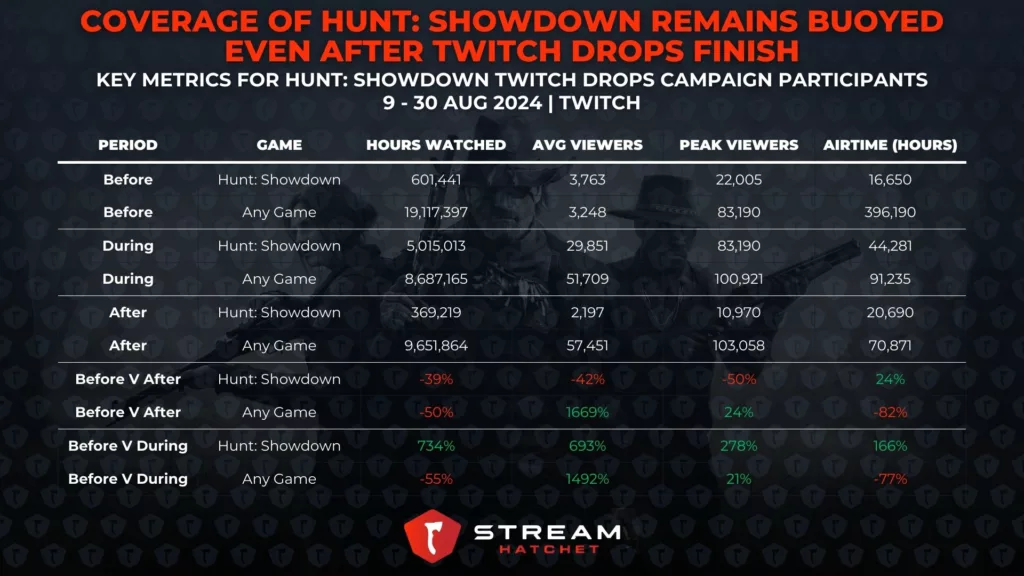
At first, comparing viewership in the before and after periods for participating streamers alone shows that their hours watched for games other than Hunt: Showdown actually decreased by 50%. However, this was largely due to a simultaneous decrease in airtime. In actual fact, participating streamers saw a whopping 1669% surge in average minute viewership (AMA) for games other than Hunt: Showdown after the Twitch Drops campaign ended. Also note that the AMAs for other games even during the Twitch Drops campaign were also boosted by a similar amount (1492%), suggesting that viewers actively jumped from participating streamers’ Hunt: Showdown streams to their other content strands.
This positive effect tends to bounce from participating streamer to developer, building one another up. As the participating streamer sees an influx of new viewers, their confidence in Hunt: Showdown increases and encourages them to play more of the game. For that reason, we also saw a 24% increase in airtime for Hunt: Showdown among participating streamers even after the Twitch Drops campaign was over. In fact, this is almost identical to the 23% increase in airtime that Hunt:Showdown saw as a whole after the Twitch Drops campaign (shown in the first graph).
Driving Community Chat Engagement Can Be More Important Than Raw Viewership
As mentioned, Twitch Drops aren’t just about gaining new followers. They’re about showing the game’s existing fanbase that the developers care and that new content is coming down the pipeline. To that end, having actively engaged members of the fanbase is even more important than simple spectators just tuning in to grab in-game loot.
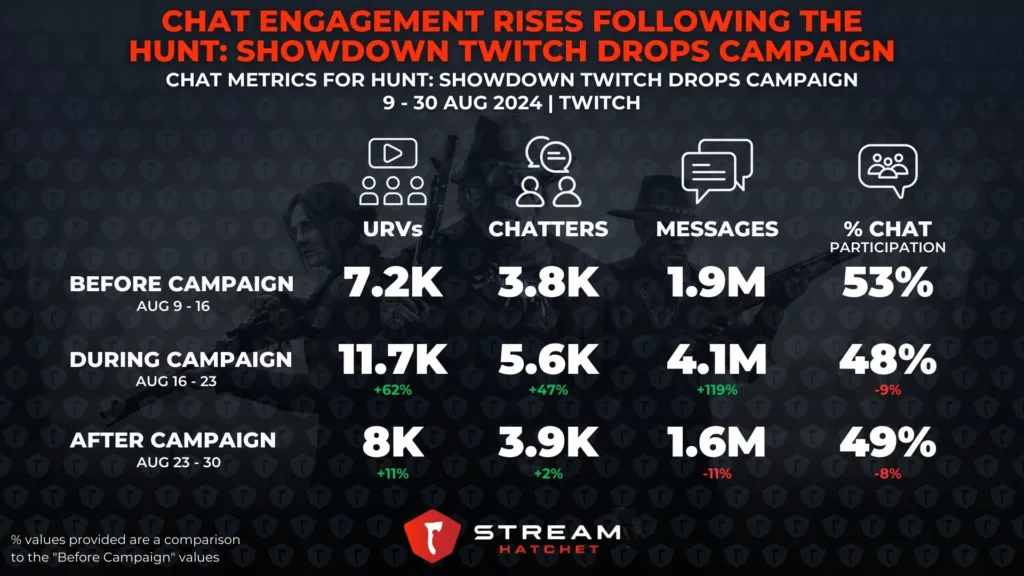
In the case of the Hunt: Showdown’s Twitch Drops campaign, the game saw a slight boost in chat engagement. During the campaign, the number of unique registered viewers jumped up 62% to 11.7K, which then subsided back to 8K after the Twitch Drops campaign ended – still an overall 11% increase in URVs compared to pre-campaign levels. Put more simply, roughly one-sixth of all new users who checked out Hunt: Showdown during the Twitch Drops campaign stuck around after the campaign was over. This is even more impressive considering the “before campaign” figures include the update’s launch day.
It’s not all rosy, however. Chat participation dropped both during and after the Twitch Drops campaign by roughly 9%, while the number of messages dropped 11% after the campaign. This drop in chat engagement may be due to having less speculation around the new update which would have fueled pre-update discourse. Regardless, nearly 50% chat participation is still great engagement for an FPS game – perhaps the difficulty of Hunt: Showdown contributes to viewer desire to discuss strategies online.
Twitch Drops campaigns benefit the developer through increased hours watched, the participating streamer through new viewers, and the fanbase through new in-game loot and a flood of players in matchmaking. It’s worth remembering that the reason for Hunt: Showdown’s successful Twitch Drops campaign was that it didn’t stand alone: It acted as a promotional event for new content and a sign of faith that the live service title would continue to release exciting updates going forward. Stream Hatchet will be watching for the next big Twitch Drops event in the coming months.
To find more in-depth analysis about live-streaming platforms, follow Stream Hatchet:

